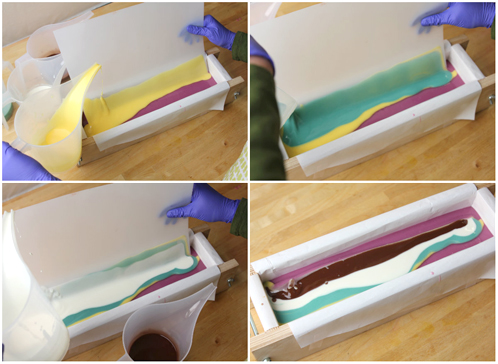Today I took a leap of faith, flew solo.
A was busy and I had the time, so decided to make some soap - alone! I wanted to use the 18 bar wooden mold and use Jasmine as the scent. Most of the recipes I found were for smaller batches; however, I found one called Soap Classic from 30 year veteran soap maker Kathy Miller's web site www.millersoap.com. This sounded like just what I needed. All the ingredients were present and accounted for, so I started measuring the following:
Soap Classic
26 - 30 oz cold water (lower for essential oils, higher for troublesome fragrance oils
12 oz Lye
30 oz Olive Oil (for harder soap substitute 2 oz of cocoa butter for 2 oz of the olive oil)
24 oz Coconut Oil
18 oz Palm Oil
Once I had all the ingredients measured out (but not mixed together), I realized this was going to be a huge batch of soap, probably much bigger than I had anticipated, so with out further ado I poured and stuffed all the ingredients back into their containers and decided to keep looking. I want to use the Soap Classic recipe in the future but feel that A and I could easily split a batch into 2 and get creative (in different ways, colors, fragrances etc) with each one.
After another search I wound up on Soap Queens blog (http://www.soapqueen.com/bath-and-body-tutorials/tips-and-tricks/formulating-cold-process-recipes/) and found the following breakdown:
Old Faithful:
This recipe is solid and reliable, and the Castor Oil gives it a super luscious lather. This is a great recipe for beginners because it’s simple and produces great results. It is very similar to our Lots of Lather Quick Mix.
This recipe is solid and reliable, and the Castor Oil gives it a super luscious lather. This is a great recipe for beginners because it’s simple and produces great results. It is very similar to our Lots of Lather Quick Mix.
32% Coconut
32% Palm
32% Olive Oil
4% Castor Oil
| 10″ Silicone Loaf Mold (50 oz.) | 9 Bar Birchwood Mold (48 oz.) | 18 Bar Birchwood Mold (96 oz.) | 5 lb. Wood Log Mold (80 oz.) | |
| Coconut Oil | 10.8 oz. | 10.5 oz | 21.12 oz. | 17.2 oz. |
| Palm Oil | 10.8 oz. | 10.5 oz. | 21.12 oz. | 17.2 oz. |
| Olive Oil | 10.8 oz. | 10.5 oz. | 21.12 oz. | 17.2oz |
| Castor Oil | 1.4 oz. | 1.3 oz. | 2.6 oz. | 2.1 oz. |
Since this recipe was perfect in all ways but lye/water info I decided to check out the SoapCalc site (www.soapcalc.net/info/helptext.asp) and see if I could figure out how to use it and come up with the correct lye/water amounts for the Old Faithful 18 bar soap.
First I printed the directions, which were very clear, then I added the weight of my ingredients, chose the kind of lye I was using, and after 6 steps I clicked on calculate and the amount of water and lye needed popped up! I was set and using soap calc was easy, very really user friendly.
I measured the lye and water amounts and slowly (with goggles, gloves and long sleeves) added the lye to the water (never water to lye) in my kitchen sink. I mixed up the oils then once the temperatures on both were around 100 degrees, I slowly added my lye/water mixture to the oils.
Once the batch reached a light trace I poured off a bit into two measuring cups (about a 1/2 - 2/3 c. each) I mixed green chrome oxide into one (1 T sunflower oil to 1/2 tsp color), and in the other fizzy lemonade ( 1T sunflower oil to 1 tsp yellow and 1/2 tsp titanium dioxide white didn't want it too bright). The main batch was light but I wanted it almost white so added (1T sunflower oil + 1 tsp ++ titanium dioxide), mixed it in with the hand blender until it was very light. I mixed in the yellow and green colors with the soap and all three colors were holding steady at a light to medium trace. I added the lighter soap to the mold and got ready to add the color when I realized I'd forgotten to add the fragrance, oops!
Once all the color was used I took a pick and slowly pulled it back and forth across the top to create a swirl pattern in green and yellow. I finished it off by doing the same thing across the original swirl.
It looked pretty good if I do say so. I tapped the mold several times to release air bubbles, and it was time to insert the plastic divider. As I approached the soap, disaster struck. Three of the sections of the divider fell into the soap - not good, not good at all! I carefully removed the three pieces and tried to re-swirl the design; it was somewhat successful. Hopefully no one will notice.
By the way the jasmine scent from Natures Garden http://www.naturesgardencandles.com smells great, did not accelerate trace, and did not discolor the soap - YAY!!
A did make it by later in the afternoon and we un-molded the Neon Swirl soap and the Cat Vomit,
the Neon Swirl looked great, smelled very light and summery and will be ready to go in 6 weeks.
On the other hand the Cat Vomit looks, um, interesting, has pretty colors, lots of texture (which it isn't supposed to have, it's supposed to be smooth, but I digress) and it smells great. We aren't sure what to do with it, re-batch or sell, guess time will tell, we will be sure to let you know which way we go on this.

















































































